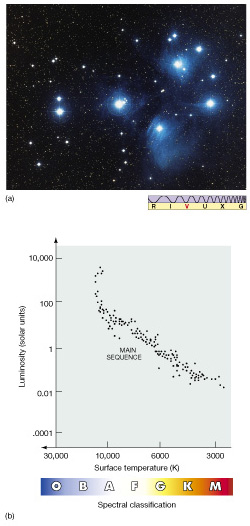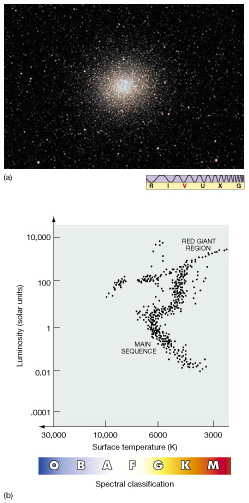Pre-lab # 10: The Pleiades and Star Clusters
Extending the Cosmic Distance Scale
We have already discussed the connections between luminosity, apparent brightness, and distance. Knowledge of a star’s apparent brightness and its distance allows us to determine its luminosity using the inverse-square law. But we can also turn the problem around. If we somehow knew a star’s luminosity and then measured its apparent brightness, the inverse-square law would tell us its distance from the Sun.
Spectroscopic Parallax
Most of us have a rough idea of the approximate intrinsic brightness (that is, the luminosity) of a typical traffic signal. Suppose you are driving down an unfamiliar street and see a red traffic light in the distance. Your knowledge of the light’s luminosity enables you immediately to make a mental estimate of its distance. A light that appears relatively dim (low apparent brightness) must be quite distant (assuming it’s not just dirty). A bright one must be relatively close. Thus, measurement of the apparent brightness of a light source, combined with some knowledge of its luminosity, can yield an estimate of its distance. For stars the trick is to find an independent measure of luminosity without knowing the distance. The H–R diagram can provide just that.
If we determine a star’s spectral type and assume that the star lies on the main sequence, we can read the star’s luminosity directly off an H-R diagram. Then, knowing the star’s luminosity, we can determine its distance by measuring its apparent brightness and using the inverse-square law. In practice, the “fuzziness” of the main sequence translates into a small (10–20 percent) uncertainty in the distance, but the basic idea remains valid. The existence of the main sequence allows us to make a connection between an easily measured quantity (spectral type) and the star’s luminosity, which would otherwise be unknown. This process of using stellar spectra to infer distances is called spectroscopic parallax. This unfortunate name is very misleading, as the method has nothing in common with stellar (geometric) parallax other than its use as a means of determining stellar distances.
Star Clusters
The end result of cloud collapse is a group of stars, all formed from the same parent cloud and lying in the same region of space. Such a collection of stars is called a star cluster. Because all the stars formed at the same time out of the same cloud of interstellar gas, and under the same environmental conditions, clusters are near-ideal “laboratories” for stellar studies—not in the sense that astronomers can perform experiments on them, but because the properties of the stars are very tightly constrained. The only factor distinguishing one star from another in the same cluster is mass, so theoretical models of star formation and evolution can be compared with reality without the complications introduced by broad spreads in age, chemical composition, and place of origin.
|
Figure 11.26 Open Cluster (a) The Pleiades cluster (also known as the Seven Sisters or M45) lies about 120 pc from Sun. (b) An H–R diagram for the stars of this well-known open cluster. (NOAO) |
Clusters and Associations
Figure 11.26(a) shows a small star cluster called the Pleiades, or Seven Sisters, a well-known naked-eye object in the constellation Taurus, lying about 120 pc from Earth. This type of loose, irregular cluster, found mainly in the plane of the Milky Way, is called an open cluster. Open clusters typically contain from a few hundred to a few tens of thousands of stars and are a few parsecs across. Figure 11.26(b) shows the H–R diagram for stars in the Pleiades. The cluster contains stars in all parts of the main sequence. The blue stars must be relatively young, for, as we saw in Chapter 10, they burn their fuel very rapidly. (Sec. 10.7) Thus, even though we have no direct evidence of the cluster’s birth, we can estimate its age as less than 20 million years, the lifetime of an O-type star. The wisps of leftover gas evident in the photograph are further evidence of the cluster’s youth.
Less massive, but more extended, clusters are known as associations. These typically contain no more than a few hundred stars, but may span many tens of parsecs. Associations tend to be rich in very young stars. They are very loosely bound, and may survive for only a few tens of millions of years before dissolving in the Galactic tidal field. Open clusters are also eventually destroyed, but generally live much longer—hundreds of millions or billions of years. It is quite likely that the main difference between associations and open clusters is simply the efficiency with which stars formed—that is, how large a fraction of the original cloud ended up in the form of stars.
Figure 11.27(a) shows a very different type of star cluster, called a globular cluster. All globular clusters are roughly spherical (which accounts for their name), are generally found away from the Milky Way plane, and contain hundreds of thousands, and sometimes millions, of stars spread out over about 50 pc. The H–R diagram for this cluster (called Omega Centauri) is shown in Figure 11.27(b).
|
Figure 11.27 Globular Cluster (a) The globular cluster Omega Centauri is approximately 5000 pc from Earth and some 40 pc in diameter. (b) An H–R diagram for some of its stars. (J. Lodriguss) |
The most outstanding feature of globular clusters is their lack of upper main-sequence stars. In fact, globular clusters contain no main-sequence stars with masses greater than about 0.8 times the mass of the Sun. (The A-type stars in this plot are stars at a much later evolutionary stage that happen to be passing through the location of the upper main sequence.) Their more massive O- through F-type stars have long since exhausted their nuclear fuel and disappeared from the main sequence. On the basis of these and other observations, astronomers estimate that all globular clusters are at least 10 billion years old. They contain the oldest known stars in our Galaxy. Astronomers speculate that the 150 or so globular clusters observed today are just the survivors of a much larger population of clusters that formed long ago.




